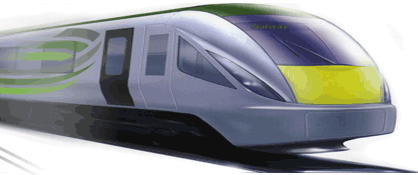West=On=Track
-News
Restored Western Rail
Corridor will reinvigorate west
Irish Times -21st May
2005
Martin Mansergh
In recent years, greater financial latitude has made
possible the selective restoration of abandoned transport
infrastructure, including engineering feats of the 18th and
19th centuries.
One hundred and eighty years ago, it was possible to take
the night boat along the Royal Canal from Mullingar to
Dublin. Canal barges carried goods, up to 50 years ago. The
restoration of the Ballinamore-Ballyconnell Canal, now the
Shannon-Erne Waterway, for leisure purposes, to a state far
more satisfactory than in its short-lived original period of
operation, has had a tremendous impact on rural parts of
counties Leitrim and Cavan. The Ulster Canal is a future
project of Waterways Ireland, going beyond care and
maintenance, that must await the decision of a restored
Northern Executive.
The most notable rail restoration has been the
reinstatement of the Harcourt Street line in Dublin as a
modern tramway. It is good to see the Milltown viaduct in
use again after 45 years.
All over the country, the rail network is undergoing
renewal. Yet, waiting at Limerick Junction, one can still
look down and see ironwork from the Belfast shipyard
securing the rails, marked H & W 1903, and muse at all
that has passed over it since. Old stations at Drumcondra,
Foxford and Monasterevin have been reopened.
The part of the western rail corridor between Ballina and
Limerick that was down to a solitary train in each direction
before closure in 1976 now has, as a pilot project, a
successful, well-used commuter service of eight trains a day
in each direction between Ennis and Limerick. The
Cork-Youghal line, closed to seaside excursion in 1981, is
to be restored, initially to Midleton, as part of integrated
strategic planning for the greater Cork area.
Communities up and down the west coast are determined to
see the whole line between Limerick and Sligo restored. For
over 20 years, the respected sociologist Fr Micheal Mac
Greil SJ cut a forlorn figure in arguing this vision. He was
even served with a bill by CIE for his legal action to
prevent the track being lifted, but won the backing on this
point of Seamus Brennan in his first term as transport
minister in 1992.
Restoring an overgrown track and crumbling stations has
the great advantage of no site acquisition costs attached or
cumbersome planning procedures to go through. A conference
in Castlebar on Friday of last week on "The Western Rail
Corridor: A Regional Transport Initiative" was told that the
restored line was a linchpin of the national spatial
strategy in the west, connecting hubs and gateways, and four
airports at Sligo, Knock, Galway and Shannon. The present
estimated cost of euro350 million would be less than the
individual cost of most big Dublin infrastructural projects.
Sensible people see the necessity of easing acute
development pressures on Dublin, by creating other poles of
attraction.
There is a superficial case for focusing only on
restoring the Limerick-Claremorris section. But that would
only reinforce the disparity between Galway and the
north-west, large parts of which have seen population
decline by more than 50 per cent since 1926. In the case of
motorways between Dublin and Dundalk and between Naas and
Portlaoise, much extra benefit came when the separate
sections were joined up.
Tourists are advised by guidebooks that there are only
limited rail services in Ireland. If the western rail
corridor (and the Athlone-Moate-Mullingar link) was
restored, the whole system would be reconnected, and touring
Ireland by rail (supplemented by bus) would be feasible
again. Regional tourism growth, over concentrated in Dublin,
needs rebalancing. This will help.
The conference was told that 8,000 containers from Mayo
pass through Waterford port annually, and that two firms
alone in Ballina and Castlebar despatch 11,000 containers.
The opportunity would be there to do a lot more of this
business by rail, in a way that would by-pass more congested
routes round Dublin.
The running down of freight by CIE, while it may make
commercial sense to them, is not in the public interest. Few
lines are overloaded, especially at night. Scotland, a
country the same size and with a similar population of 5
million to Ireland, has allocated euro44 million over a
three-year period to support rail freight.
All the main political parties were present in force in
Castlebar to lend their support to the project, including
Government Ministers Martin Cullen and Eamon O Cuiv, Fine
Gael leader Enda Kenny, and Labour's Michael D Higgins, with
a good quorum from the Seanad.
It is a public transport project which will complement
the modernised radial lines to the west from Dublin. A
positive decision to rebuild the whole line, in consecutive
phases, is now confidently expected from the Government
within months, particularly since there has been a
significant underspend so far in the public transport
allocation for the BMW region under the current National
Development Plan.
If parts of the country far from Dublin are given the
infrastructural improvements at relatively modest cost that
will make all the difference to people's lives, they will
not begrudge the heavy investment that is required in and
around the capital. There is often as much satisfaction in
restoring something abandoned as building something entirely
new.
The late John Healy wrote a book on the closure of the
railway line as a metaphor for the abandonment of
Charlestown and the north-west, based on Irish Times
articles entitled "No one shouted stop". Just as Knock
airport is a monument to the memory of Mgr Horan, the
restored western rail corridor will be a testament to
visionaries like John Healy and Fr Mac Greil, to the energy
of the West-on-Track organisation and the Western
Development Commission, the elected members and officials of
all adjacent local authorities, and the Government that will
have approved it.
|
